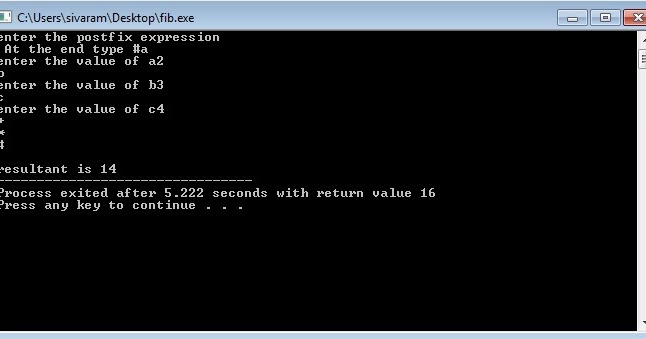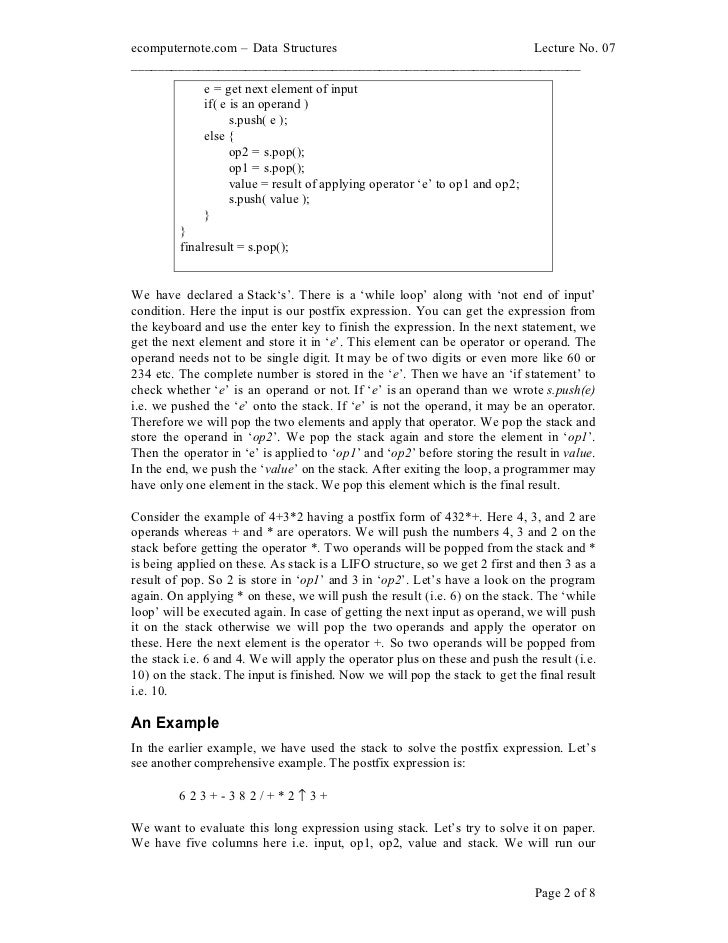- Evaluation Of Postfix Expression
- Java Code To Evaluate Postfix Expression Using Stack
- Postfix Expression Examples
- Program For Evaluation Of Postfix Expression Using Stack In Java
In this video, we learn to write a C program to evaluate postfix expressions using stack data structure. Using a Stack to evaluate postfix expression. Stacks have many uses, including the evaluation of expressions. Toevaluate an expression, we write it in postfix form, sometimescalled reverse Polish notation, in which the operands occur firstfollowed by the operator. C++ Program to Evaluate an Expression using Stacks Posted on August 6, 2013 by Manish. This C++ program, using a stack data strucure, computes value of postfix expression which pushes operands and pops these values on encountering an operator.

I've changed the code and managed to obtain the 'pop' value, but the operation didn't work.
C program to convert infix to postfix using stack, What is mean by infix to postfix conversion and how to convert infix to postfix using stack. Infix to postfix converter, infix to postfix. Infix expression is the expression which contains the operator in between two operands. Evaluating a postfix expression in c++. Rate this: Please Sign up or sign in to vote. /* The program will evaluate a postfix expression that contains digits and operators. The program tries to simulate the microprocessor execution stack or evaluation of expression. C++ evaluate postfix using stack. Infix to Postfix in C.
Jens Erat3 Answers
Peter MortensenUpdate response to code changes
I can confirm you changed the code, but not in a good way.
Evaluation Of Postfix Expression
- The code mostly has all the flaws it already had, and a few more.
- What good is that you now combine the operands into a stringstream?
- You now switch on (operand1,operand2)...
- both are uninitialized
- (operand1,operand2) means basically (operand2) in this context (sequence operator)
- your branch labels are ... operators (+-/*)
- you now print a final result which is the concatenation of all digits in the input (if you ever reach the end of the program without crashing)?
Among the things that were wrong before, and should still be fixed
- the mental model of a stack calculator.
- numbers (integers) are the operands (so 9, 100, 39829 are valid operands)
- +-/* are the operators (
operatorsoperate on theoperands) - the stack is an operand stack, not an operator stack (operators do not have to be remembered, because they are evaluated immediately)
- numbers consist of 1 or more
digits(0123456789) in a row; so you'd need to read several characters before you can 'push' anumberon theoperand stack - the
operators+-/* take 2operands, so any operation on a stack of size<2 is an error (you need to check that or the program will crash while trying to access memory that doesn't exist or contains rubbish).
That should be enough to get you started.
Two things I do think are positive:
- You program compiles. +1 for you actually using a compiler there :)
- You took the repeated
operation.push(result)out of the switch so it isn't duplicated anymore. +1 for coding style ...
I hope you can gather from this that the code isn't very good (to put it mildly), and I really think some basic exercises are in order: 1. write a simple for loop that prints numbers 1 to 10 to the console 1. write a simple while loop that prints words entered by the user 1. use a simple loop to print all numbers between 1 and 50 that are multiples of 7 1. use a switch statement to print 'yes' whenever the user enters one of the letters a, b, k, or z 2. make a simple loop that only prints the input character for every character that follows the identical (so 'abccdefgghijkllmabcdd' would become 'cgld') 1. use the same loop but this time print every word that immediately follows the identical word (so 'no, no, you should not pop, pop, but push, pop' becomes 'no pop')

That should give you a feel for how things really work, without the guesswork or the 'magic factor'.
Oh, and don't forget, I implemented the whole thing for you below. I don't suggest you blindly copy it (it will be rather obvious to your teacher :)) but it is there for you to take a peek if you want to know, what I mean with all my words above :)
You are pushing loose digits, not parsed numbers
In line 31 you pop a possibly empty stack (resulting in segfault unless you use the debug-mode STL flags on your compiler)
Just for fun:
Test output: (note that you can continue with the remaining, partially evaluted, stack after pressing carriage return)
seheseheJava Code To Evaluate Postfix Expression Using Stack
There are many things wrong with the code, starting with parsing of the input expression. The actual crash is most probably due to the fact that if you input something like '12+' you will push '1' and '2' into the stack (note: characters 1 and 2, not values 1 and 2!!!) and then try to extract two operands and an operator that you never inserted into the stack.
On parsing the input, you are reading character by character, and only using the first digit, the parsing is not able to handle spaces or any other separator... Try to break the problem in two: parsing and processing. The problem of parsing can be tackled by not using the actual values read, but just printing them (or storing in some form and then printing the whole read expression), and can be a first step. Ensure that the parser is able to deal with common expressions like '1 2 +', '10 20 +', '1 2+', ' 1 2 + ' (note the different positions of spaces) in a robust way. And that it fails gracefully to parse expressions like ' +', '1 +', '1 2 ++'... You can never trust user input, they will make mistakes and that should not bring your program to its knees.
Postfix Expression Examples
Once you are sure that you are able to parse the input, start on the actual algorithm. Make it robust against invalid user inputs that you might have not been able to tackle before, like '10 0 /' and do the actual processing.
Program For Evaluation Of Postfix Expression Using Stack In Java
Learn to use the debugger, it will help you understand when things go south what are the reasons. The debugger would take less than one second to point at the specific problem in your code above, it will not tell you why it died, but it will show you how it died and what the state of the program was there. If my hunch is correct, then it will point you at the operation.top() instruction as the culprit, and you will be able to see that you were trying to extract more elements than were inserted. Execute a part of your program step by step to understand what it is actually doing, and you will notice that when you read '12+' you are actually storing two seemingly unrelated integers into the stack (the ASCII values of '1' and '2'...
 David Rodríguez - dribeas
David Rodríguez - dribeas